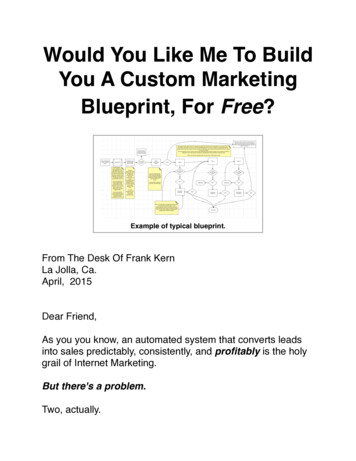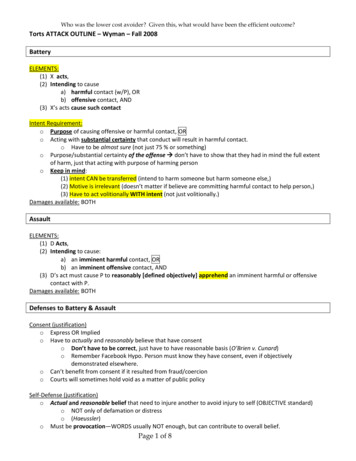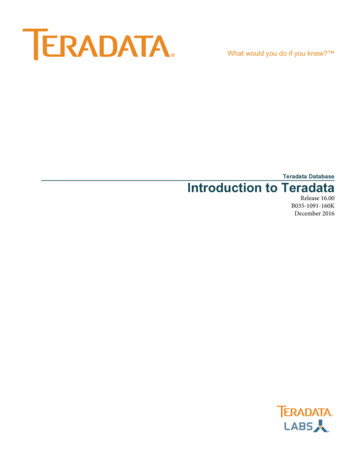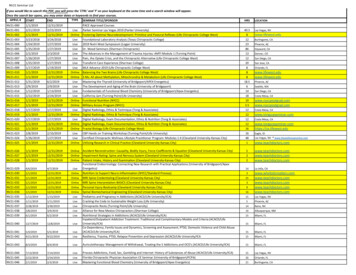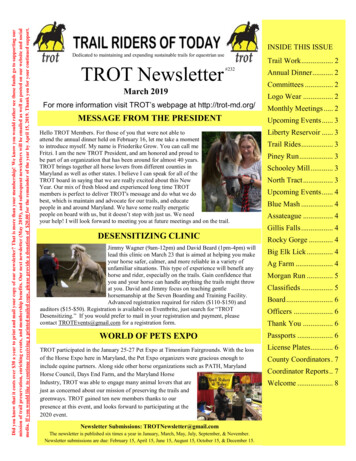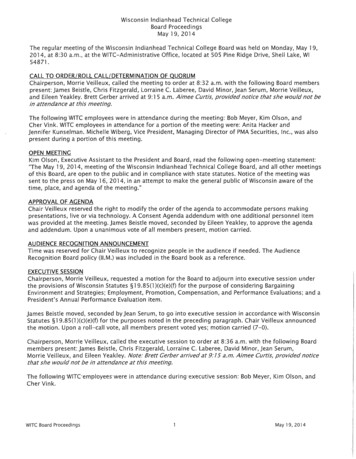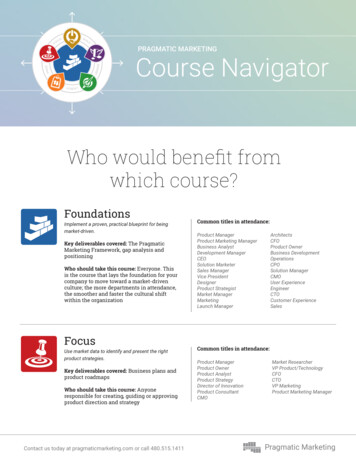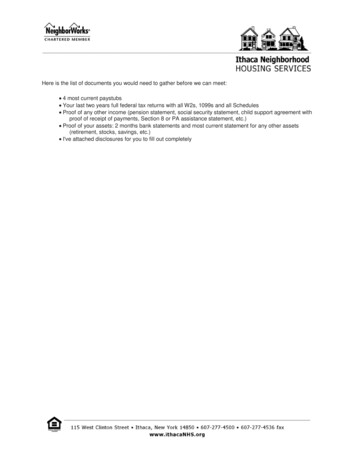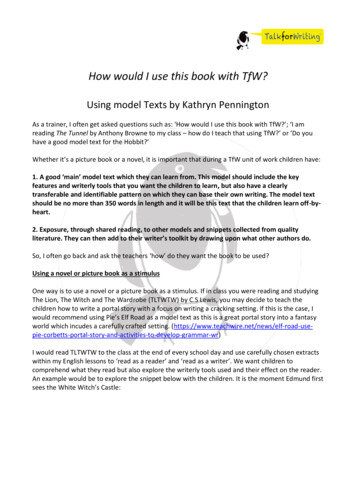
Transcription
How would I use this book with TfW?Using model Texts by Kathryn PenningtonAs a trainer, I often get asked questions such as: ‘How would I use this book with TfW?’; ‘I amreading The Tunnel by Anthony Browne to my class – how do I teach that using TfW?’ or ‘Do youhave a good model text for the Hobbit?’Whether it’s a picture book or a novel, it is important that during a TfW unit of work children have:1. A good ‘main’ model text which they can learn from. This model should include the keyfeatures and writerly tools that you want the children to learn, but also have a clearlytransferable and identifiable pattern on which they can base their own writing. The model textshould be no more than 350 words in length and it will be this text that the children learn off-byheart.2. Exposure, through shared reading, to other models and snippets collected from qualityliterature. They can then add to their writer’s toolkit by drawing upon what other authors do.So, I often go back and ask the teachers ‘how’ do they want the book to be used?Using a novel or picture book as a stimulusOne way is to use a novel or a picture book as a stimulus. If in class you were reading and studyingThe Lion, The Witch and The Wardrobe (TLTWTW) by C.S Lewis, you may decide to teach thechildren how to write a portal story with a focus on writing a cracking setting. If this is the case, Iwould recommend using Pie’s Elf Road as a model text as this is a great portal story into a fantasyworld which incudes a carefully crafted setting. mar-wr)I would read TLTWTW to the class at the end of every school day and use carefully chosen extractswithin my English lessons to ‘read as a reader’ and ‘read as a writer’. We want children tocomprehend what they read but also explore the writerly tools used and their effect on the reader.An example would be to explore the snippet below with the children. It is the moment Edmund firstsees the White Witch’s Castle:
You could then add to the toolkit and learning by reading other snippets like this one.
The novel becomes a stimulus. A rich resource to draw ideas and inspiration from, but ultimately, weare not asking our children to write The Lion, The Witch and the Wardrobe! If we are asking childrento write a short portal story, then their main model needs to be a short portal story.The Learning JourneyTo summarise the learning journey: Outcome: Portal StoryFocus: SettingModel text: Elf RoadSupporting Literature: CLASS BOOK: The Lion, The Witch and The Wardrobe (& 2 other snippets).Similarly, Pie’s Zelda Claw works well as a model when reading, Varjak Paw by S. F. Said. So again thelearning journey could be: Outcome: Adventure / Quest storyFocus: SuspenseModel text: Zelda ClawSupporting Literature: CLASS BOOK: Varjak Paw (& 2 others snippets)It works for non-fiction too. Pie’s: ‘Buy Now: Multifunction Mobile Phone and ‘Buy Now: Multipurpose Spy Key Ring,’ works alongside the Alex Rider series by Anthony Horowitz which can befound here: https://www.teachprimary.com/learning ere are some other suggestions:BookSuggested Model Text written by PieCorbettSquash and a squeeze by Julia DonaldsonThe Squeaky StoryRosie’s WalkCharlie’s WalkWe’re going on a bear huntTake a Walk Little BearHow the Whale Became and other stories by How the Tiger Learned Not to be GreedyTed Hughes& How the Tortoise got its ShellA Traveller in Time by Alison UtterlyBack in timeThe Mozart Question (or WW2 themed book) Gas MaskThe Water Tower by Gary CrewAlien LandingDead Man’s Cove or Famous 5 SeriesAdventure at Sandy CoveSafia and the CaptainSome picture books are fine to be used as a model text e.g. Farmer Duck because they follow thegolden principles of being easy to innovate, filled with memorable, meaningful repetition and includethe key language features/structures that you would want your children to internalise and learn.
Rewriting a model based on a bookTrying to write a model text by rewriting or abridging an original comes with a warning – no onedoes Philip Pullman like Phillip Pullman, but there are some, often traditional tales, which needrewriting to deliver exactly what you need – almost to make them ‘more teachable’.Pie has rewritten many traditional tales to ensure that they include key language patterns, a clearstructure and memorable meaningful repetition.We need to ensure that model texts teach children key, transferablelanguage patterns that can be built upon year after year. Our aim is tocreate confident, imaginative and independent writers, so we need toensure that the tools and models that we expose them to support themin this journey. More information and 15 example model texts can befound in Talk for Writing in the Early Years.I have included two example models at the back of this article that arebased on the following books: Lost and Found by Oliver Jeffers (model written by CazzWilliams, Y1 Literacy Lead at Warren Road) Mr Big by Ed Verr (written by me)An alternative idea is to take a model text (I always use Pie’s) and adapt it so that it is based on thebook. Have a look at Little Charlie and the Lighthouse Keeper model texts at the end of this article.This is actually Pie’s story Little Charlie but adapted to run alongside the Lighthouse Keeper’s Lunch.When I did this with some Year 2 teachers this story became our model, but every day we stillplanned to read the actual Light House Keeper’s Lunch and explore it in depth. The model text ismuch easier for the children to learn and innovate upon.So, how would I use the Hobbit as a model text?When I’m asked, ‘How would I use the Hobbit as a model text?’ I nowreply, ‘I wouldn’t’. Instead I would use The Hobbit as a stimulus but writeor adapt my own model which has the underlying pattern of a quest /adventure story and includes similar characters e.g. goblins, trolls andelves. An example of this is Pie’s ‘opening chapter’ model text, which is inthe style of The Hobbit and can be found in the Year 6 Writing Modelsbook.3 approaches to considerThere are 3 approaches to consider when creating a model text:1) Using a novel or a picture book as a stimulus2) Rewriting an original story3) Writing your own – This article hasn’t looked at this option. Writing your own is the mostdifficult option, but also the most rewarding. I’ve written a separate article with advice onthis that will be made available online and featured in the next term’s TfW newsletter.
Some final key points Having a model text is vitally important. Without showing children a model of what isexpected, it is a little bit like saying to them: ‘Today I am going to teach you how to playtennis, but I’m not actually going to show you what playing tennis looks like.’ Pitch your model texts high, make them aspirational but achievable and teach with highexpectations. Make sure that teachers are looking critically at their models and thinking –what will my children learn from this model and add to their writer’s toolkit belt? Although creating and/or finding the right model text can take time, once done, you willalways have it. Collect a bank of model texts and use them year on year – just tweak themto meet the needs of your new class.Kathryn is a former Assistant Head of a large primary school in Northamptonshire, where shesuccessfully led the Talk for Writing approach and worked as a Lead Literacy Teacher, AdvancedSkills Teacher and a Specialist Leader of Education. Kathryn provides Talk for Writing trainingthroughout the UK.Web: www.talk4writing.co.uk/trainers/kathryn/Email: kathryn.pennington@talk4writing.comModel Texts included below1)2)3)4)Zelda Claw by Pie CorbettLost and Found by Cazz Williams, Y1 Literacy Lead at Warren Road SchoolMr Big by Kathryn PenningtonLittle Charlie and the Lighthouse Keeper written by Pie Corbett, adapted by KathrynPennington & Y2 teachers at St Andrews Primary School
Zelda Claw and the Rain CatAll night, thunder growled overhead. Zelda crouched in the darkness, staring. Wind lashed theglistening tarmac and the streetlights flickered; Zelda shivered. Where could she escape from therain?At that moment, Zelda heard something crawling along the pavement, hidden by shadows. A vagueshape slipped into a doorway. A green eye flickered. Zelda’s fur prickled as she watched. What wasit?Without thinking, Zelda dashed under a lorry and crouched as still as stone. Silently, the shadow ofan enormous cat paced through the darkness, sinking along the rain washed pavements. Zeldashivered.Slowly, the great rain cat drew closer and closer. Zelda could hear its claws scratching on the tarmacand see its green eyes glittering. Had it seen her?At that moment, Zelda could bear it no longer. Leaping out from under the lorry, she shot back acrossthe rain-swept road and jumped over the wall. She was alone. The rain cat had not followed her.Zelda was safe – for now. Pie Corbett 2012Lost and FoundSomewhere north of Italy there lived a boy. One cold, winter’s day he founda penguin slumped at his door. The penguin looked sad and the boy wascurious. He thought it might be lost.First, the boy decided to row the penguin to the South Pole. They rowed andthey rowed and they rowed for many days and nights. A storm raged andthey trembled with fear.Next, the penguin cautiously shuffled out of the boat, The boy said, “Goodbye” and floated away,but the penguin looked sadder than ever.After that, the boy realized that the penguin wasn’t lost – he was lonely!Quickly, he powered back to the South Pole as fast as he could. The boy searched but the penguinwas nowhere to be seen.Finally, the boy saw something in the water. He rushed closer and closer until he could see thepenguin! They both felt delighted and gleefully sailed home together and lived happily ever after.
Mr Big (KS1)Once upon a time, there was lonely Gorilla called Mr Big who lived in a littlehouse on the edge of a rainy city. Mr Big was very good at playing the pianoand wished that he had some friends to play music with.Early one morning, Mr Big woke up and decided to go and look for somefriends to play in his band.First, he walked and he walked and he walked past the sticky swamp, until he reached the local park.Slowly, he opened the park gate and he looked up and down but unfortunately there weren’t anyfriends at the park to play with. So he carried on walking.Next, he walked and he walked and he walked across the wibbly, wobbly bridge, until he reached thelocal library. Carefully, he opened the library door and looked left and right, but unfortunately, thereweren’t any friends in the library to play with. So, he carried on walking.After that, he walked and he walked and he walked through the swishy, swashy meadow until hereached a local school. Cautiously, he opened the school door and looked round and round.Fortunately, he saw lots of children playing drums, shaking maracas and singing loudly. “Would youlike to join my band?” asked Mr Big.“Yes please,” the children replied.So, Mr Big skipped home. He skipped and he skipped and he skipped past the oozy, sticky swamp,across the wibbly, wobbly bridge and through the swishy, swashy meadow until he reached his littlehouse on the edge of a sunny city.Finally that evening, all of the children came round to play in Mr Big’s band and they all had awonderful, musical time. From that day on, Mr Big was never lonely again.Four leaf clover, our story is over.Mr Big (KS2)Slumped in his chair, Mr Big stared out of the window. He watched as raindrops raced down thewindow, autumn leaves departed from the skeletal trees and streetlights flickered. With his headhung down, he made his way slowly to the bedroom and fell asleep.Early the next day, Mr Big woke to the sound of relentless rain beating down on his window.Reluctantly, he got dressed and made breakfast for one – toast (he always had toast). Slowly, he puton his heavy coat and went outside for his morning walk. As he trudged down the puddle-patchedstreet avoiding people’s glances, he would mutter, “Why does no one see me?” Then, out of thecorner of his eye, he saw an abandoned piano.Without hesitation, Mr Big rescued the piano, took it home and started to practise. He practised andhe practised and he practised, all day and all night, for two whole weeks. It seemed Mr Big was goodat playing the piano - very good. As people passed his window, they would stop to listen to hisuplifting music. They watched as Mr Big would dance, sing and fill the air with his talent. His musicspread across the town like sunlight rising in the morning.
Then, one sunny Saturday morning, Mr Big received an invitation to join the town’s band. Punchingthe air in delight, he accepted and that evening he skipped all the way to band practice with his headheld high. Smiling to himself, Mr Big spent the whole night playing piano with his new musical family.It was the best night he had ever had!The following week, and for every week after that, Mr Big attended band practice. However, he stillenjoyed, every now and then, sitting proudly in his chair where he would wave at those that passedby, warm his toes on the sun’s rays and sing along with the birdsong.Little Charlie and the Lighthouse Keeper.Once upon a time there was a little boy called Charlie who lived near the sea.Early one morning, he woke up and his Mother said, “Take this bag of goodies to the Lighthousekeeper.” Into the bag, she put a slice of cheese, a loaf of bread and a square of chocolate.Next, he walked, and he walked and he walked till he came to a bridge. There he met a cat – a leancat, a mean cat.“I’m hungry,” hissed the cat angrily. “What have you got in your bag?”“I’ve got a slice of cheese, a loaf of bread” but he kept the chocolate hidden!“I’ll have the cheese please,” said the cat. So Charlie gave the cheese to the cat and it ate it all up.Then, he walked, and he walked and he walked till he came to a pond. There he met a duck – a snowy,white duck.“I’m hungry,” quacked the duck softly. “What have you got in your bag?”“I’ve got a loaf of bread,” but he kept the chocolate hidden!“I’ll have the bread please,” said the duck. So Charlie gave the bread to the duck and it ate it all up.After that, he walked, and he walked and he walked till he came to a tall town clock – tick tock, ticktock, tick tock. There he met not one, not two but three scruffy seagulls. “We’re hungry,” moanedthe seagulls loudly. “What have you got in your bag?”Unfortunately, there was only the chocolate!Luckily, Charlie found some crumbs.So he scattered them on the ground and the seagulls ate them all up.Next, he walked, and he walked and he walked till he came to a crossroads. There he met a .nobody.“Mmmm, I’m hungry ,” said Charlie. “What have I got in my bag?”“Mmmmmm, chocolate!” So, he ate it all up!Finally, he walked, and he walked and he walked till he came to the Lighthouse. There he met theLighthouse Keeper .“I’m hungry ,” said the Lighthouse Keeper. “What have you got in your bag?”Unfortunately, there was only the chocolate wrapper.Luckily, the Lighthouse Keeper’s wife made pizza and chips for tea.
the style of The Hobbit and can be found in the Year 6 Writing Models book. 3 approaches to consider There are 3 approaches to consider when creating a model text: 1) Using a novel or a picture book as a stimulus 2) Rewriting an original story 3) Writing your own – This article ha



